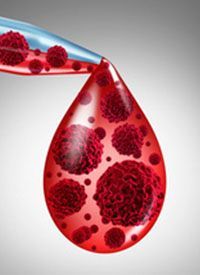Article
Iomab-B Yields Beneficial Rates of HCT in Relapsed/Refractory AML
Author(s):
The use of 131-iodine generated high rates of allogeneic hematopoietic cell transplantation in patients with relapsed/refractory acute myeloid leukemia who did not achieve a complete response following standard therapy.

The use of 131-iodine (Iomab-B) generated high rates of allogeneic hematopoietic cell transplantation (HCT) in patients with relapsed/refractory acute myeloid leukemia who did not achieve a complete response (CR) following standard therapy, according to data from the phase 3 SIERRA trial (NCT02665065) presented at the 2022 Transplantation & Cellular Therapy Meetings.1
Patients achieved 100% neutrophil and platelet engraftment after Iomab-B conditioning and allogeneic HCT. Patients also had a lower incidence of sepsis on this treatment regimen.
A total of 153 patients were enrolled and randomized 1:1 to either the Iomab-B HCT group (n = 76) or the conventional care group (n = 77). In the conventional care group, those who achieved a CR when on to receive HCT or physician’s choice standard of care. Those who did not achieve a CR could cross over to the Iomab-B group (n = 40).
Patients needed to be 55 years or older with a Karnofsky performance score of 70 or more. Additionally, patients needed to have a human leukocyte antigen (HLA)–matched related or unrelated donor, and experienced primary induction failure. The primary end point was durable complete remission at 6-months, and the secondary end point was overall survival.
Between days 7 and 12, patients received a 20 mCi or less dosimetric dose followed by imaging and 24 Gy of Iomab-B to the liver. After day 12, patients received 30 mg/m2 of fludarabine daily and 200 cGy of total body irradiation followed by HCT.
The median age was 65.0 years vs 66.1 years in the Iomab-B and conventional care groups, respectively. The majority of patients in the experimental and control arms, respectively, had adverse (60.5% vs 62.3%) cytogenetic and molecular risk, while others had favorable (5.3% vs 3.9%), intermediate (32.9% vs 33.8%) risk. In terms of disease status at randomization, the majority of patients in both respective groups experienced primary induction failure (56.6% vs 50.6%), and others had first early relapse (22.4% vs 27.3%), had relapse/refractory disease (14.5% vs 15.6%), and had second relapse (6.6% vs 6.5%). Additionally, patients in the Iomab-B group had a median of 30% (95% CI, 4%-97%) marrow blasts at randomization compared with 19.5% (95% CI, 2.8%-97.4%) in the conventional care group.
Prior to enrollment on the trial, 66% of patients received targeted therapies, with 66% of those patients receiving venetoclax (Venclexta)-based therapy with a median of 3 prior regimens. Of those in the conventional care group, 47% had received prior targeted therapy, 81% of which were venetoclax-based. Treatment was unsuccessful in 50% of patients who were allowed to cross over to receive Iomab-B.
Of the 76 patients in the Iomab-B group, 66 received HCT. Of the 77 patients in the conventional care group, 14 received standard of care HCT. The median Iomab-B activity in the experimental group compared with the control group that crossed over was 649.5 mCi vs 606.5 mCi. Patients had a median dose to marrow of 15.9 Gy vs 16.1 Gy in the Iomab-B group and in the control group for those who crossed-over. The median number of days to absolute neutrophil count (ANC) and platelet engraftment was 14 days and 17 days in the Iomab-B arm, 13 and 17 days in the crossover arm, and 16 and 14 days in the standard of care arm, respectively. Only 1 case of engraftment failure was reported in the standard of care arm.
On day 100 or more, the non-relapse mortality occurred in 6 of 65 evaluable patients in the Iomab-B group, 2 of 40 in those who crossed-over, and 2 of 14 in those who achieved a CR in the conventional care group.
In terms of notable grade 3 or higher adverse effects (AEs) occurred in 10% or more of patients, the most significant was sepsis (P = .002), which occurred in 5.3% of patients in the Iomab-B group, and 23.7% of those in the conventional care group. Other common AEs in both respective groups included febrile neutropenia (33.3% vs 44.7%), mucositis (12.0% vs 11.8%), hypertension (12.0% vs 13.2%), and pneumonia (8.0% vs 13.2%). Device related infection was observed in 5.3% of patients in the Iomab-B group, and 2.6% in the conventional care group. Additionally, a small portion of patients experienced acute kidney injury (4.0% vs 2.6%), and venoocclusive liver disease (1.3% vs 0.0%) between both groups, respectively.
Reference
- Gyurkocza B, Nath, R, Seropian SE, et al. High rates of transplantation in the phase III SIERRA trial utilizing anti-CD45 (Iodine) 131I-Apamistamab (Iomab-B) conditioning with successful engraftment and tolerability in relapsed refractory (R/R) acute myeloid leukemia (AML) patients after lack of response to conventional care and targeted therapies. Presented at the 2022 Tandem Meeting; April 22-26, 2022; Salt Lake City, UT. Abstract 40.






%20(2)%201-Recovered-Recovered-Recovered-Recovered-Recovered.jpg?fit=crop&auto=format)

%20(2)%201-Recovered-Recovered-Recovered-Recovered-Recovered.jpg?fit=crop&auto=format)
%20(2)%201-Recovered-Recovered-Recovered-Recovered-Recovered.jpg?fit=crop&auto=format)